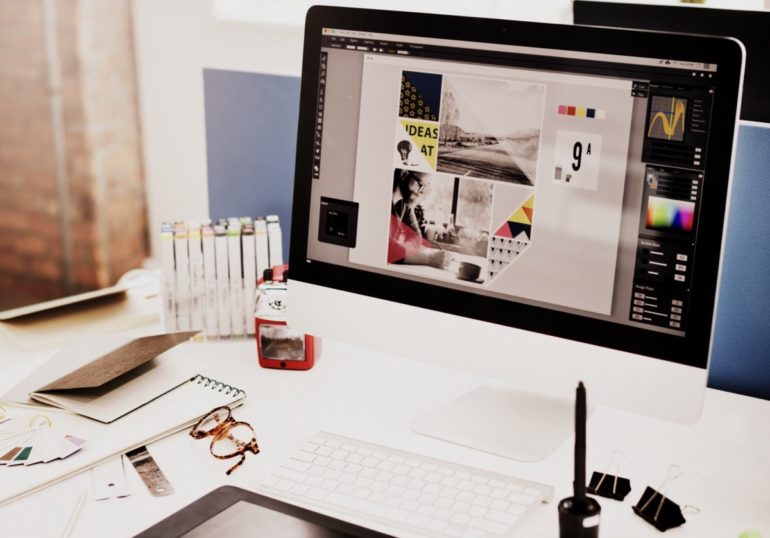Years ago, my family and I moved from a cramped two-bedroom apartment into a spacious house. Instead of having to squeeze my home office in half a room, I finally had a nice 10′ x 12′ room all to myself.
Since I was accustomed to working in less than half this area, I knew I’d have plenty of room to work with, so I wanted to intelligently organize it in a way that would allow me to work efficiently on a variety of projects without creating a cluttered mess.
While browsing a local bookstore before the move, on a whim I bought a book called Organizing From the Inside Out, by Julie Morgenstern. It contained many great organizing tips and adroitly explained where people normally go wrong when trying to get organized. I’d like to share with you what I learned from reading this book and organizing my home office from scratch.
 It’s a skill
It’s a skill
Julie’s book starts off with a strong statement that at first I didn’t believe. She says that if you’re one of those people who are surrounded by clutter and just can’t seem to get organized, then you simply never learned how to get organized.
If you maintain a messy environment, it just means you lack the skills of organizing, which anyone can learn.
Having read several other books on organizing since then, I feel that Julie is partly right. Organizing can be broken down into a step-by-step process that anyone can follow.
What creates clutter?
Julie points out several technical flaws that can prevent one from becoming organized, but my perception is that at a basic level, there is really just one flaw: a failure to systematize common decisions. Whenever I leave things lying out, it’s because I’m not ready to decide what to do with them yet.
So the process of organizing really comes down to having a system for automating decisions about where everything goes.
Disorganized people have few or no systems, so they must make every decision on a case by case basis. Eventually this becomes overwhelming, and clutter begins to pile up.
Organized people will make far fewer decisions in the long run. It takes far more time to be disorganized than it does to be organized, because disorganized people lose so much time to inefficiency.
Learning how to get organized
Now let’s outline a step-by-step process for organizing your home office from start to finish.
Analyze: The first step is analysis. How do you spend your time in your office? Make a list of the different types of tasks you perform there, and create a list of functional zones that your office will need. If you are a programmer, this should be an easy task if you think of it in terms of designing a computer program. If you had to program a robot to perform all the different tasks you did in your office, how would you organize those tasks into separate modules? For instance, I came up with a list of six categories for myself: general paperwork, computer work, creative work, financial work, business reading, and manual order processing and shipping. Ideally, you want to create a list of clearly defined categories that overlap as little as possible.
Needs: Next, determine what physical equipment and materials you need for each category. For instance, for creative work I need access to writing instruments, design notebooks, a marker board, and a corkboard. For shipping orders, I need access to packaging materials, recordable media, postage, a postal scale, and so on. At this step I realized I also needed a storage and reference zone for my books, files, and extra supplies.
Sort: Now that you have your office materials functionally divided into different zones, the next step is to assign physical areas of your office to each zone. Ideally you want these zones to overlap as little as possible, but some overlap is usually necessary, especially if you use your computer for many different tasks. Take some time to determine an arrangement of furniture that will best suit your functional needs.
Visualize: A key to this stage is to envision what your ideal office would look like. Forget about what furniture you already own, and don’t worry about cost or space constraints at this point. Just use your imagination, and think about what you’d really want if cost were irrelevant. Write this down on paper, and even sketch out your ideal office layout, noting which work zones you would assign to each physical area.
Furnish: Now that you know what you want for your ideal furniture layout, brainstorm ways you can get as close to that ideal as possible, given budget and space constraints. Many people, myself included, have inherited old furniture that no longer serves them. Just because you happen to already own it doesn’t mean it’s the right choice for you today.
Don’t be afraid to sell old furniture and replace it with something more functional. You can find plenty of reasonably priced self-assembly office furniture at office superstores, and many offer free delivery. I bought my computer desk, hutch, rolling drawer cabinet, and printer stand for a total of $99 new, but I had to assemble them myself. I also bought three six-foot folding tables for about $35 each, and they can be moved around easily.
Additionally, I picked up five stacking shelves (60″ tall, 36″ wide, 10″ deep) for only $20. Bookcases are cheap too, about $40-60 for one with six shelves. If you want that hand-carved mahogany desk, you’ll pay a premium for it, but if you go for the basic, functional stuff, you can fill your office with furniture for just a few hundred dollars, even if you buy everything new. Measure furniture and play with different configurations in your favorite image editing software. Or make paper cut-outs to scale and experiment with them. It’s much easier to do this than physically moving the furniture around.
Storage: Now that you’ve settled on an office furniture layout, place the equipment, materials, and supplies for each zone into that zone. As you determine how to zone your office, you might want to have redundant supplies for convenience. I need writing instruments for most tasks, so I have containers for them on both sides of the room.
Don’t store things just where they seem to fit. Store materials as close as possible to the point where you’ll actually use them. Inconvenient storage can easily lead to clutter. If you’re always losing pens, for instance, perhaps it’s because you don’t have pen containers located where you actually need them. Let your functional needs dictate your office layout.
At this poin,t you have a nice design for your office layout, and you’ve planned out zones for all your activities. But how do you deal with the existing clutter and ensure that it doesn’t return?
The solution is to find out what patterns there are to your clutter and create simple systems to deal with it. Piles of clutter often accumulate simply because you don’t know what to do with all those pieces of paper, or you haven’t yet found the time to make all the necessary decisions those piles represent.
Sort the clutter
Sort all the items in those piles of clutter. For this task you can place several boxes on the floor and begin placing items into the boxes. The key is to sort items in a way that makes sense from a functional standpoint. Ask yourself under what conditions each item would be needed, and sort items by similar conditions. For instance, I had one box for stuff that needed to be filed, another box for design materials, another box for trash, and so on. Even though it may seem like a good idea, don’t start putting things away just yet. When clutter accumulates, there’s usually a good reason for it, and you want to learn why such items turned into clutter, even if you know where those items should go.
Now that you’ve sorted the clutter, grab one of the boxes and take a look at the contents. Ask yourself why these items ended up as clutter. It’s most likely because you didn’t have a good system for dealing with these items. Maybe these items don’t have an assigned home, or maybe the storage location you’ve assigned them is too inconvenient, so it’s easier just to leave them out. Maybe you have items that need to be filed, but you don’t yet have a file for them, and your blank file folders are inconveniently stowed away deep in your closet. Ask yourself under what conditions each item might not have ended up as clutter. This will give you a clue as to how to prevent the clutter from returning.
Give every object a home
As you go through the boxes one by one, assign a home to each item. Where will you put those old bank statements? Where should all those design notes go? If you had a box for trash, go through those items and note what should have been thrown away. If you assign a convenient home to every item, you will be much more inclined to put them away. Once I did this I found that my office was self-maintaining. I always put things away because the storage for items is right next to where they’re used.
Assign appropriate containers for items. Take a trip to the local office supply store to get an idea of all the different types of containers that are available, or browse a web site such as OfficeDepot.com. Don’t be afraid to buy new storage such as drawers and shelves once you identify a need for them. Where clutter has accumulated, most likely items either have no home, or the storage isn’t convenient. Acknowledge your true needs — don’t fight them. If you have a short bookcase, would a taller one serve you better? If your trash container seems to be constantly overflowing, replace it with a larger one, or place multiple trash containers in different areas of your office. I found two trash containers to work much better for me than just one, so I always have one within reach when I need it, and I don’t have to empty them as often.
For many years I’ve used something called a project box (similar to a literature sorter) to organize materials. It is a wooden box about three feet across, one foot high, and one foot deep with four small cardboard drawers, four shelves, and a book/binder storage area. I like this because it provides very versatile and accessible storage. I use the shelves to store current paperwork I need to handle, and I use the drawers for frequently accessed materials like banking and mailing supplies. The drawers are fully removable, so I can take them out when I need them and put them back when I’m done. Any office store will also carry a variety of plastic drawer cabinets, ranging from small desktop units to larger floor cabinets on wheels. The drawers are usually made of clear plastic, so you can always see the contents inside. Small drawers are great for storing things like postage, rubber stamps, and other odds and ends that may clutter up your work area.
If your space is tight, go vertical. There are many storage units that can be mounted on walls or stacked vertically. Also note the space beneath tables. Many containers can fit in those spaces to store infrequently accessed supplies.
Put it away
Once you’ve sorted the clutter, chosen the right containers, and assigned convenient homes for everything, take the time to put everything where it should go. This shouldn’t take long at all if you’ve made all the decisions in advance. Don’t take any shortcuts, or they will come back to haunt you later. Disorganized people make life harder by forcing themselves to always make a new decision on where each item should go. Organized people establish systems so that the proper place for each item is obvious; thus, no new decisions have to be made each time. For instance, when I receive postal mail, I automatically place the bills and financial statements into the bills drawer, the junk mail into the trash, the magazines into the magazine rack, and items that require other processing into my inbox.
To me the greatest benefit of getting organized has been a greater ability to concentrate when working and a greater ability to relax when not working. Working in a self-maintaining, uncluttered environment can increase productivity by making the process of work flow more smoothly. If you feel that excess clutter is overwhelming your ability to relax and enjoy your work environment, take the time to make your organizing decisions in advance about where everything should go and why. Then you can focus on getting your real work done, since you’ll be able to quickly recognize where each object goes and conveniently put it away.







